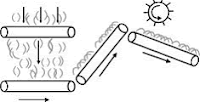-->
-->
In melt spinning the fiber polymer is melted and the molten solution is forced through the spinneret. As the soft filaments emerge from the spinneret into the cooler environment, they harden into a standard filament form. Melt spinning requires no chemical change & any kind in the polymeric material from which the fiber is formed. It does require that the fiber polymer can be melted without altering the chemical state of the material. Fibers formed by this process are Nylon, Polyester, and glass.
Emulsion Spinning
Emulsion spinning is not used to a great extent but it is important for selected types of specialty fibers. Some raw polymeric materials cannot be processed by wet/dry/melt methods, because they either breaks drown when heated to a melting temperature or are not soluble in solution that can be used. For these substances the emulsion process is necessary.
The polymer dispersed or emulsified into a solution, the dispersion or emulsion is then forced through a spinneret, and as the emulsion leaves the spinneret, the polymer form into a fibrous shape. Depending on the type & fiber, the fibrous form produced by this method may be staple / filament length. Teflon is an example of a fiber spun by the emulsion process. First, polymers, whether natural or synthetic, must be converted into liquid form to be spun. This is done either by dissolving the polymer in a suitable solvent or by melting it. This polymer solution or polymer melt is sometimes referred to as the spinning dope. Cellulose, the raw material for most naturally derived manufactured fibers, is not easily dissolved. Accordingly, the cellulose polymer is usually modified before it is dissolved. Synthetic polymers are put together in the plant before the dissolution or melting step.
Before actually forming the fiber, certain characteristics can be added to the polymer material. Many manufactured fibers are naturally bright, with a high luster. If dull or semi-dull fibers are wanted, delustering agents can be added to the molten polymer to break up light rays and decrease shine. Colored pigments, flame retardants, and compounds to absorb ultraviolet light can also be added. Occasionally substances are added during polymer synthesis so that they are incorporated into the polymer molecules themselves.
Wet Spinning
Wet-spun polymers are, like dry-spun polymers, converted into liquid form by dissolving them in a suitable solvent. The polymer solution is extruded through a jet into a liquid bath. The bath causes coagulation and precipitation of the fiber. Solvents are usually recovered from the liquid bath and are recycled. Viscose rayon and some acrylics are wet spun.
It is possible to add special chemical reagents to the liquid bath that produce selected changes in the fiber. This is done in the manufacture of some high-strength rayons, for example; into a liquid bath. The bath causes coagulation and precipitation of the fiber. Solvents are usually recovered from the liquid bath and are recycled. Viscose rayon and some acrylics are wet spun. The polymer or substance to be used is making the fiber is dissolved into some type & solution, then is forced through the spinning jet into another liquid, which react with fiber solution the process involves one & the following reaction:
(a) The fiber polymer may have been chemically changed in order to make it soluble in the solvent used when this occurs the fiber solution reacts with the receiving solution & reverses the chemical reaction so that the material is reformed into a fiber shape. The difference is that in reforming, a filament fiber shape has been made rather than a polymer in some other form, such as fibrous mass, chip or pellet. This process refers to the fiber solution as a derivation & the fiber form, the solution into which this passes is the coagulating bath & the actual process is typically called regeneration.
(b) Wet-spinning may also be used when the fiber solution does not change the chemical form of the fiber. The solution is forced into a coagulating bath, which reduce the concentration of the fiber solution sufficiently to reform the fiber, this time in a filament form Fibers formed by wet spinning are rayon, acrylicA variant of wet spinning, called dry-jet wet spinning, has been developed to produce some of the newer fibers such as the aramid. Instead of the spinneret being immersed in the spinning bath, it is placed slightly above the bath so that there is a small air gap, usually less than an inch. The fibers exiting the spinneret can be stretched to orient the molecules before they enter the bath to be solidified.
This process develops high orientation and crystallinity in one step, rather than drawing in a separate step Although melt-, dry-, and wet-spinning techniques are used to form the vast major-ity of manufactured fibers, several other spinning techniques also exist and may be applied in a limited number of specialized situations. High-molecular-weight poly-mers, such as those in Spectra@ polyethylene, are formed by solution spinning or gel spinning. As in wet and dry spinning, the polymer is dissolved in a solvent. The polymer and solvent together form a viscous gel that can be processed on conventional melt-spinning equipment to form a gel-like fiber strand. Later in the processing, the solvent is extracted and the fibers stretched. Fibers made from polymers that have extremely high melting points and are in-soluble present obvious difficulties in spinning. Such materials may be spun by a complex process called emulsion spinning in which small, fibrous polymers are formed into an emulsion, aligned by passing the emulsion through a capillary, then fused or sintered (combined by treating with heat without melting), passed through the spin-neret into a coagulating bath, and subsequently stretched











